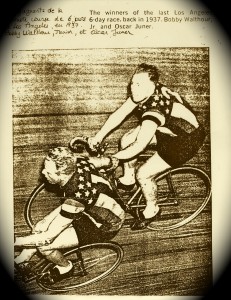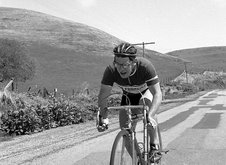
The World’s Fastest Bicycle Sprint
By Erich von Neff
There are those that say it was the fastest bicycle sprint that there ever was. Since no official time was taken this certainly can be questioned. And there is the tendency to believe that an earlier era had some of the “right stuff” that the present lacks. Then, too, there are very few left who remember it. And most of these can be found holding forth in waterfront bars, such as Schlegels.* So it can be fairly asked: Why even bother to mention something that may be no more than a myth?
Well, as will be seen, there really may be a reason to believe that it really did happen. Let us, then, examine the facts if this can be done dispassionately.
It all began inauspiciously enough at the Half Moon Bay to Pescadero Race held on Columbus Day of 1952. This annual event which had its origins in the fringes of pre-consciousness, as even those old timers in Schelgel’s Bar will grudgingly attest, for even they cannot remember when it first started.
Louis Meyer who was maitre d and part owner of Bardelli’s in San Francisco had donated a 1938 Bentley sedan as the first and only prize.
A customer had died, leaving the Bentley for his tab, which, in any case, an all too honest brother had paid. So Louis Meyer decided to donate the Bentley, not that he couldn’t have kept the Bentley and enjoyed driving it. But Louis Meyer had been a professional cyclist in France, and had even placed tenth in the Tour de France; which was very good indeed since, he had been a team domestic to Nicolas Frantz.**
Because of the prize, this race would be no mere formality. Club teams and riders would be pulling for their own leaders; and classification groups would do their best to stay away from one another, though some cooperation would nonetheless be necessary.
The staccato and presto, presto of Italian could be heard grating against the booming voices of Norwegians and Germans. None of them modulated their voices. Possibly, their trades–longshoreman, slaughterhouse worker, merchant seamen, brewer–caused this exuberance, or more likely, these occupations were a sign of their zest for life itself.
Still when Lido’s Duesenberg drove up there was a brief lull, then presto, presto, “Mach schnell, Hans (quickly, Hans)” their exuberant dialogue resumed.
Men in wide brimmed sombreros flanked Half Moon Bay’s Main Street. They looked intently at the Bentley which was parked in front of Pete’s Cafe. Lido’s blonde mistress had driven it down from San Francisco and was still in the driver’s seat.
Little time was wasted starting the race. Each class rode in a circle near the starting time snaking out behind the rider who was nearest it when the starter’s gun went off. Precious seconds were saved that way, rather than starting out en masse and then sorting themselves into a pace line.
Lido stood near the Bentley chomping and smoking his cigar. There was grumbling about the handicapping, but we all know it would be useless to complain to Lido. At 8 a.m. on the dot, he fired his 38 Smith and Wesson in the air. Novice Class rode off. Shortly there was another pistol shot for Class C, another for Class B, and finally Lido discharged the remaining three rounds for Class A.
We snaked out behind Jim Manning who happened to be the rider nearest the starting line. The pace was lung bursting from the start. Whopping handicaps had been allotted at Louis Meyer’s insistence. We would have to work together with a will if we were to have even the slightest chance.
And so we barreled down Main Street leaving the Bentley, the sombreros, Lido, and the blonde well behind.
“Via, Via,” the men beneath the sombreros yelled. Soon we turned off onto Highway One. We rotated pace with surprisingly little disagreement nor did anyone say anything to Gus and Vince Gatto when, as usual, they refused to take their turns.
We rolled on, averaging close to thirty miles an hours. I will have to admit though that my brain cells are now numb to the memory of the details of our progress between Half Moon Bay and Pescadero. Basically it is a blur of spinning cranks, and the recollection that at the time I wished that each of those revolutions would be the last. Those still holding forth in Schlegel’s Bar will certainly agree.
During all this time we did not catch sight of any of the groups ahead. Until just over the crest of the last hill before Pescadero. In front of us were Classes B, C and Novice. And, in front of them, was the finish line painted across the road next to the turnoff to Pescadero. It looked as if each of these groups were rolling along fast enough to stay away.
There now transpired a series of events, though seemingly of minor significance in themselves, were to affect the pace of our sprint: At this moment, the Highway Patrol escorts from Pescadero came roaring up beside us. Their sirens b egan to scream, psyching us up, though, in this, we had no more than the groups ahead. The Bentley zoomed by driven by the blonde, Lido sat next to her, puffing on his cigar. This apparition transferred energy to all of us. Then, too, there was the crowd, mostly made up of Italian, Portuguese, Mexican and Filipino farm workers yelling for their favorites, “Gatto, Delgardo, Mesina, Guido…”
The sirens continued screaming mixed in with the din of the crowd. Our pace now matched that of the motorcycle escorts as we charged after the Bentley and the groups ahead.
Finally we converged in a massive pack of about 100–a case of almost perfect handicapping. In this melee it was a case of every man for himself. The sirens and roar of the crowd almost obliterated consciousness as we zoomed across the finish line.
The crowd began to yell, “Gus, Gus.” And this time there could be no doubt, for Louis Meyer had made sure there were some Frenchmen among those picking first place.
Gus Gatto dismounted from his bike to be kissed by the blonde, and receive the keys to the Bentley from Louis Meyer.
“Do you know how fast you were going?” one of the Highway Patrolmen said to some of the riders. We remained silent. Of course, we did not know our speed. Did it make any difference now that the race was over? “You were going sixty miles an hour.” The other Highway Patrolmen nodded in agreement.
The fastest sprinter goes forty-two miles an hour and this is under ideal conditions on a board trace. Even allowing for some inaccuracy of the speedmeters, our speed was fast indeed, and it must be remembered that close to thirty speedmeters read almost the same.
Although it is true that the motorcycles created a draft, there was a tailwind, and there was psyching up effects of the blonde and the Bentley. But more than these factors was the near perfect synchronization of more than a hundred riders, that resulted in four groups chasing each other in a frenzy until the final few seconds of the race.
Later, at the Columbus Day Dinner in Pete’s Cafe in Half Moon Bay, some of the riders asked Gus how he had won.
“Remember that Highway Patrol motorcycle, the one in front of the pack,” Gus said as he ate Lasagna. “I sprinted right for it. Sort of took a bead on it. Like when I was in anti-tanks under Patton.”
We ate more Lasagna, celebrating Columbus Day. Sicilians became Italians, if very briefly.
Gus drove the Bentley back to San Jose. Not long afterward, the Half Moon Bay to Pescadero Columbus Day Race was dropped from the racing calendar.
For those of us who were in it thoughts of that last race are revived by mellow spirits on Columbus Day.
“Was it really the World’s Fastest Bicycle Sprint?” Those old timers holding forth in Waterfront bars, such as Schlegel’s will give you argument enough. Though there will always be some who claim it as no more than a myth.
*In San Francisco
**Winner of the Tour of France, 1929.

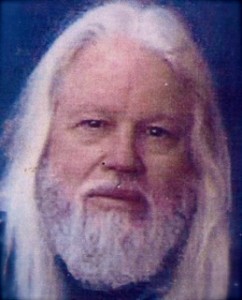



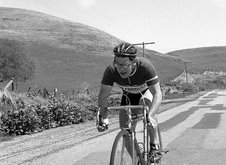
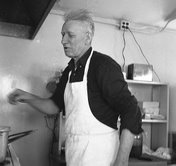
 [Author/Poet Erich von Neff is a San Francisco Longshoreman.]
[Author/Poet Erich von Neff is a San Francisco Longshoreman.]
